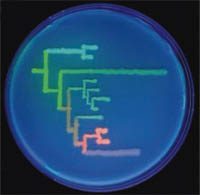 Our research investigates the molecular basis of visual adaptations in vertebrates using an evolutionary comparative approach. We use studies of natural genetic variation to investigate the molecular mechanisms underlying key functional shifts in the evolution of visual proteins. Our motivation is not only to develop a better understanding of how animals adapt to different visual environments, but also to provide insight into how visual proteins function. In order to investigate the evolutionary history of visual proteins, our research includes investigations of both resurrected ancestral proteins as well as present day visual pigments. We are also interested in applying comparative approaches to investigate mechanisms of visual disease. Current research areas include:
Our research investigates the molecular basis of visual adaptations in vertebrates using an evolutionary comparative approach. We use studies of natural genetic variation to investigate the molecular mechanisms underlying key functional shifts in the evolution of visual proteins. Our motivation is not only to develop a better understanding of how animals adapt to different visual environments, but also to provide insight into how visual proteins function. In order to investigate the evolutionary history of visual proteins, our research includes investigations of both resurrected ancestral proteins as well as present day visual pigments. We are also interested in applying comparative approaches to investigate mechanisms of visual disease. Current research areas include:
- Resurrection of ancestral proteins
- Engineering biological systems for the study of protein evolution and function
- Evolutionary transformations of photoreceptors in snakes
- Discerning patterns of selection and adaptation in response to visual ecology in aquatic environments
- Non-model systems for the study of visual pigment structure and function
- Functional defects in visual pigments associated with retinal disease
- Evolutionary bioinformatics/computational methods development.
The Chang lab is committed to research excellence in a safe and positive environment in which collaborative interactions can flourish. We welcome diversity from all ethnic, cultural, gender, religious and sexual identities, and aim to promote equity, diversity and inclusion. We are committed to providing an accessible environment in which all are treated with dignity and respect, in a culture of learning and understanding.
